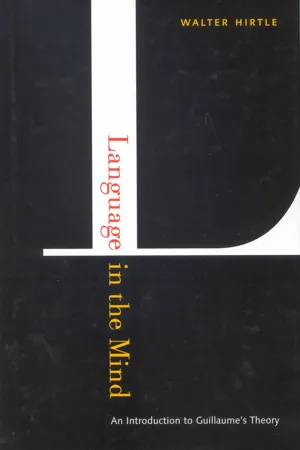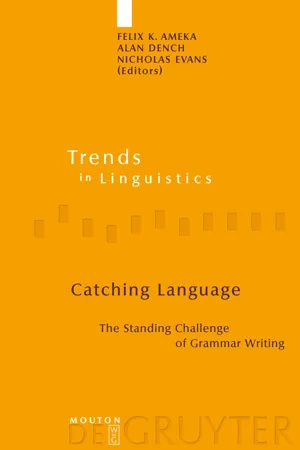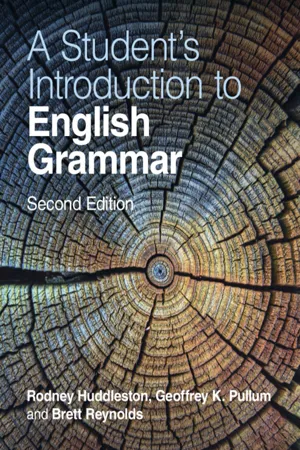Languages & Linguistics
Auxilary Verbs
Auxiliary verbs, also known as helping verbs, are used in combination with main verbs to form different tenses, voices, and moods in a sentence. They help convey the time, aspect, and modality of the action being described. Common auxiliary verbs include "be," "have," and "do," and they play a crucial role in constructing grammatically correct and meaningful sentences.
Written by Perlego with AI-assistance
Related key terms
1 of 5
3 Key excerpts on "Auxilary Verbs"
- eBook - ePub
Language in the Mind
An Introduction to Guillaume's Theory
- Walter Hirtle(Author)
- 2009(Publication Date)
- McGill-Queen's University Press(Publisher)
have . In this way there emerged a view of auxiliaries as verbs whose lexical import is no longer a particular matter but an element of such abstractness that it cannot be used in a sentence without a material input. Because its degree of abstractness, of dematerialization, is unsurpassable for a verb, the auxiliary is situated at the final limit of the transpredicative parts of speech.Recognizing that auxiliaries differ from main verbs in this way helps us understand why they are used with the quasi-nominal form of a full verb: to make up for the lexical deficiency of the auxiliary. This is not the whole story however because it does not tell us how the “helping verb” helps, or why the mind instituted in tongue the form for a lexically deficient verb, a verb lacking the lexical matter required to function as a unit of discourse. To understand this, we must take a closer look at the infinitive and participles.HOW DO AUXILIARIES HELP?
We have seen that the tenses of the quasi-nominal mood can neither situate their event with regard to the present nor take a subject. Arising at the beginning of chronogenesis, they are lacking the grammatical development found at the final instant of chrono-genesis in the tenses of the indicative. The role of the auxiliary is to make up for this lack, to provide the quasi-nominal form’s event with the grammatical determinations required. To show how the auxiliary does this calls for a rather technical explanation (cf. Hirtle 1997a), which is worth summarizing here to recall that word meaning consists of matter and form and to illustrate once again that it is the way of realizing this basic structure that determines how a word fits in with other words in the sentence, how it plays its role as a “part” of speech.As we saw in the previous chapter, the tense of the quasi-nominal form situates its event in past-oriented time but leaves undetermined its relation to the present. In a verb compound, we observe that the quasi-nominal event (or, when used with auxiliary have - eBook - PDF
Catching Language
The Standing Challenge of Grammar Writing
- Felix K. Ameka, Alan Dench, Nicholas Evans, Felix K. Ameka, Alan Dench, Nicholas Evans(Authors)
- 2008(Publication Date)
- De Gruyter Mouton(Publisher)
However, in most reference grammars of the languages that feature in these studies, or languages with a similar structure, the role of function verbs has not received the same amount of attention. Although one might expect that the intermediate status of function verbs would lead to an exhaustive coverage of their functions both in grammars and diction-aries of a given language, more often than not this is not the case. Rather, as Dixon (1991: 337) notes for English, function verbs often only receive marginal attention in reference grammars. Similar remarks can be made for dictionaries – insofar as a dictionary exists for the language in question; as we know, this not the case for many languages of the world, since even linguists who advocate the documenta-tion of small or endangered language often give very low priority to the production, let alone publication, of dictionaries. To the extent that they are accessible, dictionaries rarely provide systematic information on the com-plex lexicalised expressions formed with function verbs, either in the form of exhaustive listing, or in providing (in the entry of the function verb in question) the semantic generalisations that govern the formation of such expressions. Thus, the remarks of Hacker (1958), referring to the treatment of Hindi function verbs (here termed “auxiliaries”) in grammars and dic-tionaries, have lost nothing of their relevance: In den Grammatiken sind die Hilfsverben sehr unzulänglich behandelt. Die Angaben sind nicht nur unvollständig, sondern oft auch ungenau, irrefüh-rend oder geradezu falsch. (…) Nur wenig Material konnte aus Wörterbü-chern geschöpft werden. (…) Im allgemeinen konnten die Wörterbücher nur zur Feststellung der Bedeutungen isolierter Wörter benutzt werden. [In the Function verbs: Lexicon, grammar, or both? 361 grammars, the auxiliaries are treated very insufficiently. - eBook - PDF
- Rodney Huddleston, Geoffrey K. Pullum, Brett Reynolds(Authors)
- 2021(Publication Date)
- Cambridge University Press(Publisher)
This use of have always shows lexical verb behaviour. These facts are illustrated in [23]. [23] AUXILIARY USAGE LEXICAL VERB USAGE i a. Have you told her? b. *Do you have told her? [perfect] ii a. % Has he enough money? b. Does he have enough money? g [static] iii a. % Have I to sign both forms? b. Do I have to sign both forms? iv a. *Has he these tantrums often? b. Does he have these tantrums often? [dynamic] Dare and Need Dare and need also show a complex mix of auxiliary and lexical verb behaviours, but auxiliary behaviour (as in % Dare I accept it? or % Need we tell him?) is increas- ingly rare in contemporary usage and rapidly disappearing from the language, especially in AmE (see CGEL §3.2.5.5 for details). 3.2.4 Auxiliary Verbs Cross-Linguistically The grammatical properties outlined in §3.2.1 serve to distinguish auxiliary verbs from lexical verbs IN ENGLISH. There are many languages, however, that have verbs commonly referred to as auxiliaries, so we need to consider for a moment what is meant by ‘auxiliary verb’ as a term that could be applied generally across languages. A definition of the concept of an auxiliary verb that could be applied across languages would say that auxiliary verbs form a small, grammatically distinct subclass of verbs whose members characteristically accompany another verb and 54 Verbs and Verb Phrases tend to convey meanings or mark grammatical systems which, in other languages (or even elsewhere in the same language), are expressed by inflection of the verb. Most of the auxiliary verbs in English (the ones with the special properties relating to inversion and negation) carry information about tense, aspect, voice, or the modal system as shown in [24]: [24] AUXILIARY VERB CARRIER OF EXAMPLE i have perfect tense Sue has written the preface. ii be progressive aspect Sue is writing the preface. iii be passive voice The preface was written by Sue. iv may, can, must, etc. modality Sue may write the preface.
Index pages curate the most relevant extracts from our library of academic textbooks. They’ve been created using an in-house natural language model (NLM), each adding context and meaning to key research topics.


